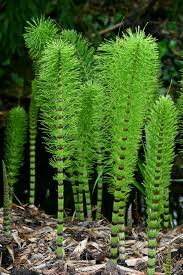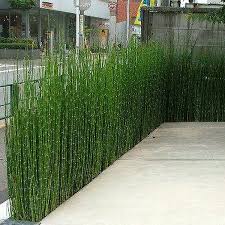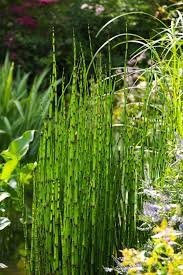Horsetail Grass, also known by its scientific name Equisetum, is a unique and ancient plant that has been around for millions of years. This special plant is often called “horsetail” because its appearance resembles a horse’s tail.
Horsetail Grass is not like the grass you see on lawns. It’s a type of plant that doesn’t make flowers like most plants do. Instead, it reproduces using spores. These are tiny particles that help the plant grow and make new plants.
One cool thing about Horsetail Grass is its structure. It has hollow stems that can look like little tubes. These stems can be rough to touch because they have a lot of tiny bumps. The plant can vary in size, with some types growing very tall, while others are quite short.
Horsetail Grass loves to be around water. You can often find it near rivers, streams, or even in wetlands. It’s like a plant that enjoys taking a nice, long drink. Because of this, some people use it as an indicator of where water is, like a nature compass.
People have used Horsetail Grass for different reasons over time. Some Native American tribes used it as a natural remedy to help with swelling or to stop bleeding. They would crush the plant and use it like a bandage. Horsetail Grass also has silica in it, which is a mineral that can help plants and even humans stay strong.
Gardeners might find Horsetail Grass a bit tricky to deal with. It can spread quickly and sometimes be hard to control in a garden. But in the wild, it plays an important role in the ecosystem. It provides shelter for small animals and insects, and its spores become food for some creatures.
So, next time you come across Horsetail Grass, remember that it’s not just any ordinary plant. It’s a survivor from ancient times, with a simple yet fascinating life story.
Read Also: An Estimate of how much you will spend in raising 100 Pullets
Growing and Care Guide of Horsetail Grass

Growing and taking care of Horsetail Grass can be an interesting and rewarding endeavor. Here’s a simple guide to help you get started:
Planting
1. Choose a location: Horsetail Grass prefers damp or wet soil, so pick a spot near a water source or in a low-lying area of your garden.
2. Soil preparation: Ensure the soil is well-draining and rich in nutrients. You can add compost to improve the soil quality.
3. Planting method: You can plant Horsetail Grass using rhizomes (underground stems). Plant them about 2-3 inches deep in the soil.
Watering:
4. Keep the soil moist: Horsetail Grass loves water, so make sure the soil doesn’t dry out completely. Water it regularly, especially during dry season.
5. Avoid waterlogging: While the plant likes moisture, it doesn’t do well in waterlogged conditions. Make sure the soil has proper drainage to prevent root rot.
Sunlight
Partial shade: Horsetail Grass prefers partial shade, especially in hot climates. It can tolerate some sunlight, but too much direct sun can scorch its delicate stems.
Maintenance
1. Containment: Horsetail Grass can be invasive, so consider planting it in containers or using barriers to prevent it from spreading uncontrollably.
2. Pruning: Trim any dead or yellowing stems regularly to encourage healthy growth.
3. Fertilization: Apply a balanced liquid fertilizer during the growing season to provide the plant with essential nutrients.
4. Mulching: A layer of organic mulch can help retain moisture in the soil and suppress weed growth.
Pests and Diseases
1. Generally hardy: Horsetail Grass is quite resilient, but it can still fall victim to pests like aphids or diseases like fungal infections.
2. Inspect regularly: Keep an eye on the plant for any signs of damage or unusual growth. Treat pest or disease issues promptly to prevent them from spreading.
Propagation
Rhizomes: You can divide and replant mature Horsetail Grass by carefully separating the rhizomes and planting them in new locations.
Remember that Horsetail Grass has a tendency to spread, so keep a watchful eye on its growth. While it might require some attention to prevent it from taking over, its unique appearance and ability to thrive in damp environments make it a fascinating addition to gardens with the right conditions.
Benefits of Horsetail Grass

Horsetail Grass offers a range of potential benefits, thanks to its unique composition and historical uses. Here are some of the potential benefits associated with this plant:
1. Rich in Minerals: Horsetail Grass is a natural source of various minerals, including silica, which is essential for the growth and development of bones, hair, and nails.
2. Healthy Hair and Skin: The silica content in Horsetail Grass is often linked to promoting healthy hair and skin. Some people believe that consuming or applying products containing Horsetail extract can improve the condition of hair and skin.
3. Bone Health: Silica, along with other minerals found in Horsetail Grass, can contribute to bone health by supporting bone density and strength.
4. Urinary Tract Health: Horsetail Grass has been traditionally used to support urinary tract health. It’s believed to have diuretic properties, which means it can help increase urine production and potentially assist in flushing out toxins from the urinary system.
5. Wound Healing: In traditional medicine, Horsetail Grass was used as a poultice to help stop bleeding and promote wound healing due to its potential astringent and anti-inflammatory properties.
6. Anti-Inflammatory Effects: Some compounds present in Horsetail Grass may have anti-inflammatory effects, which could be beneficial for various conditions where inflammation plays a role.
7. Joint Health: Due to its mineral content, Horsetail Grass might have a positive impact on joint health by supporting connective tissues.
8. Antioxidant Properties: Horsetail Grass contains antioxidants that can help combat harmful free radicals in the body, potentially contributing to overall health and wellbeing.
9. Gardening and Landscaping: Horsetail Grass can be used in landscaping to create interesting textures and visual appeal. Its ability to thrive in wet environments makes it suitable for water gardens and marshy areas.
10. Traditional Medicine: Horsetail Grass has been used in traditional medicine by various cultures for centuries. While modern research is ongoing, its historical uses suggest a range of potential health benefits.
It’s important to note that while Horsetail Grass has a long history of traditional use and potential benefits, scientific research is still exploring many of these claims. As with any herbal remedy, it’s advisable to consult with a healthcare professional before using Horsetail Grass for its potential health benefits, especially if you have underlying health conditions or are taking medications.
Read Also: Recommended Brooding Duration for Chicks with Temperature Requirement
Where to Find Horsetail Grass near Me/You

Here are three perfect places where you might find or locate Horsetail Grass:
1. Wetlands and Marshes: Horsetail Grass thrives in damp and wet environments. Wetlands, marshes, and areas near ponds or streams are prime locations to find this plant. The natural moisture in these areas provides the ideal growing conditions for Horsetail Grass.
2. Riverbanks and Stream Edges: Look along the edges of rivers and streams where the soil is consistently moist. Horsetail Grass often grows in these areas due to the availability of water. Its presence can also be an indicator of water sources nearby.
3. Woodland Clearings: In some cases, Horsetail Grass can be found in woodland clearings or meadows with sufficient moisture. These areas can provide the right balance of sunlight and water for the plant to grow.
Remember that while these are common places to find Horsetail Grass, its growth can be influenced by local climate, soil conditions, and other factors. Always be respectful of natural environments and seek permission if you’re planning to collect plants from private land or protected areas.
Read Also: Definition of Products and the Different Product Levels
